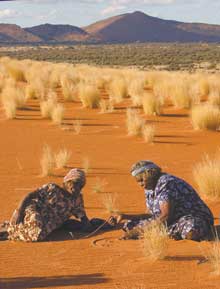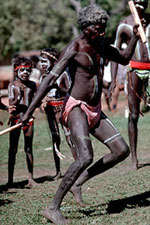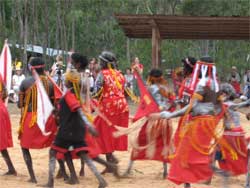Australian Indigenous cultural heritage
Warning. Australian Stories may contain the names and images of Aboriginal and Torres Strait Islander people now deceased. Australian Stories also contain links to sites that may use images of Aboriginal and Islander people now deceased.
Aboriginal and Torres Strait Islander cultures are complex and diverse. The Indigenous cultures of Australia are the oldest living cultural history in the world – they go back at least 50,000 years and some argue closer to 65,000 years. One of the reasons Aboriginal cultures have survived for so long is their ability to adapt and change over time. It was this affinity with their surroundings that goes a long way to explaining how Aboriginal people survived for so many millennia.
Cultural heritage is seen as 'the total ways of living built up by a group of human beings, which is passed from one generation to the next', given to them by reason of their birth.
In Australia, Indigenous communities keep their cultural heritage alive by passing their knowledge, arts, rituals and performances from one generation to another, speaking and teaching languages, protecting cultural materials, sacred and significant sites, and objects.
Land – at the core of belief

APY Lands, Ku Arts Tours. Courtesy of Ananguku Arts.
Land is fundamental to the wellbeing of Aboriginal people. The land is not just soil or rocks or minerals, but a whole environment that sustains and is sustained by people and culture. For Indigenous Australians, the land is the core of all spirituality and this relationship and the spirit of 'country' is central to the issues that are important to Indigenous people today.
All of Australia's Aboriginals were semi-nomadic hunters and gatherers, with each clan having its own territory from which they 'made their living'. These territories or 'traditional lands' were defined by geographic boundaries such as rivers, lakes and mountains. They understood and cared for their different environments, and adapted to them.
We cultivated our land, but in a way different from the white man. We endeavoured to live with the land; they seemed to live off it. I was taught to preserve, never to destroy.
Aborigine Tom Dystra
Indigenous knowledge of the land is linked to their exceptional tracking skills based on their hunter and gather life. This includes the ability to track down animals, to identify and locate edible plants, to find sources of water and fish.
National parks
National parks can contain sites of significance for Aboriginal communities, such as rock engravings and artwork. National parks can be significant for Aboriginal people because of Dreaming stories associated with those sites.
National parks management recognises this intrinsic relationship that Aboriginal people have with their 'country'. The land is often less disturbed by European settlement. Often the land areas have been relatively inaccessible or not suitable for European agricultural practices, or have been left relatively intact.
National Parks and Wildlife Service programs are often run in conjunction with Traditional Owners and Aboriginal communities to ensure Indigenous involvement in national and state parks is seen to be part of processes which help contribute to reconciliation, respect, recognition and cultural awareness, resolution of Native Title, training, employment and enterprise development, support for Aboriginal heritage and cooperative management of the parks and wildlife.
Diversity – location and languages
Aborigines and Torres Strait Islanders identify themselves through their land areas, their relationship to others and their language and stories - which may be expressed through ceremony, the arts, family, religion, and sports. Cultural heritage is passed on from one generation to the next.
There were about 600 different clan groups or 'nations' around the continent when Europeans arrived, many with distinctive cultures and beliefs. Their 'territories' ranged from lush woodland areas to harsh desert surroundings. Different groups developed different skills and built a unique body of knowledge based on their particular environment.

Nyawanday (Casey Ross), Spirit children. Courtesy of Kimberley Language Resource Centre.
The system of kinship put everybody in a specific relationship to each other as well special relationships with land areas based on their clan or kin. These relationships have roles and responsibilities attached to them.
Kinship influences marriage decisions and governs much of everyday behaviour. By adulthood people know exactly how to behave, and in what manner, to all other people around them as well as in respect to specific land areas. Kinship is about meeting the obligations of one's clan, and forms part of Aboriginal Law, sometimes known as the Dreaming.
Language is vitally important in understanding Indigenous heritage as much of their history is an oral history. Hundreds of languages and dialects existed (although many are now extinct), and language meaning, as well as geographic location, is used today to identify different groups.
Adaptation – tools and technology

Ludo Kuipers, George Manyita about to throw a 3-pronged fish spear, Mukarrmuli billabong near Wuymol/Bulman, an Aboriginal community in the south of Arnhem Land in the Northern Territory, 1983. Courtesy of OzOutback Internet Services.
Tools and implements reflect the geographical location of different groups. For example, coastal tribes used fishbone to tip their weapons, whereas desert tribes used stone tips. While tools varied by group and location, Aboriginal people all had knives, scrapers, axe-heads, spears, various vessels for eating and drinking, and digging sticks.
Aboriginal people achieved two world firsts with stone technology. They were the first to introduce ground edges on cutting tools and to grind seed. They used stone tools for many things including: to make other tools, to get and prepare food, to chop wood, and to prepare animal skins.
After European discovery and English colonisation, Aboriginal people quickly realised the advantages of incorporating metal, glass and ceramics. They were easier to work with, gave a very sharp edge, and needed less resharpening.
Sacred sites and Dreaming stories

Ludo Kuipers, Joli Laywonga dancing a 'bungkul' traditional dance during the opening of the library at Bamyili School in Barunga, an Aboriginal community 80 km from Katherine in the Northern Territory, 1982. Courtesy of OzOutback Internet Services.
In most stories of the Dreaming, the Ancestor spirits came to the earth in human form and as they moved through the land, they created the animals, plants, rocks and other forms of the land that we know today. They also created the relationships between groups and individuals to the land, the animals and other people.
Once the ancestor spirits had created the world, they changed into trees, the stars, rocks, watering holes or other objects. These are the sacred places of Aboriginal culture and have special properties. Because the ancestors did not disappear at the end of the Dreaming, but remained in these sacred sites, the Dreaming is never-ending, linking the past and the present, the people and the land.
For Aboriginal people all that is sacred is in the land. Knowledge of sacred sites is learned through a process of initiation and gaining an understanding of Aboriginal law. It is, by definition, not public knowledge. This is why the existence of many sites might not be broadcast to the wider world unless they are threatened.
Perhaps the most well-known sacred site in Australia is Uluru. Located in the centre of Australia, southwest of Alice Springs, the first European explorers named it Ayers Rock. The caves inside the rock are covered with Aboriginal paintings. In 1985 the Commonwealth Government of Australia returned Uluru to its traditional owners, Pitjantjatjara and Yankunytjatjara people (also known as Anangu).
Performance – music, songs, dance and ceremony

Dance performance, Garma Festival 2005. CARP file photo.
Ceremonial performances are seen as the core of cultural life. For example, for Tiwi Islanders, these performances bring together all aspects of their art – song, dance, body decoration, sculpture and painting.
Music, song and dance was and is still today a very important part of Aboriginal life and customs. There were songs for every occasion, some of which were expressed in special ceremonies.
Songs and dances were exchanged often at large ceremonial gatherings when many people gathered together and when trade goods were also exchanged. These gatherings often occurred at a time and place when there was plenty of food.
Dance is a unique aspect of ceremonies which is learnt and passed down from one generation to another. To dance is to be knowledgeable about the stories of the ancestral heroes although dancing, unlike painting and singing, is learnt at an early age.
This allows large groups of people to demonstrate their clan rights in front of an audience. Dance is also seen as an occasion to entertain and to be entertained and through the work of dance to show their love for families and kin. It is for this reason that dance may be performed at the end of every day in some communities.
Visual arts
The quality and variety of Australian Indigenous art produced today reflects the richness and diversity of Indigenous culture and the distinct differences between tribes, languages, dialects and geographic landscapes.
The emergence of 'dot' paintings by Indigenous men from the western deserts of Central Australia in the early 1970s has been called the greatest art movement of the twentieth century. Prior to this, most cultural material by Indigenous Australians was collected by anthropologists. Consequently, collections were found in university departments or natural history museums worldwide, not art galleries. That all changed at a place called Papunya and with what became known as the Papunya Tula art movement of the Western Desert.
Today Indigenous art ranges across a wide variety of mediums from works on paper and canvas to fibre and glass.The story of the way these art forms runs parallel to the history and experiences of the artists themselves. It reflects customary trading patterns, a struggle for survival and the influence of governments and churches.
A report by the Cultural Ministers' Council – Statistics Working Group in 2007 suggests that over a quarter of Australia's Indigenous population are involved in creative arts, with almost twice as many Indigenous females as males.
Tourism

Aboriginal elder. Courtesy of Tourism Australia.
Aboriginal tourism has only recently emerged as an industry. A diversity of tours and experiences that promote Aboriginal culture and lifestyle are available for travellers throughout Australia. The experiences range from organised tours to performances of dance, the purchase of traditional Aboriginal artefacts and an opportunity to stay on Aboriginal land to experience the daily lives of Aboriginal people.
Businesses vary from enterprising individuals to highly professional commercial operations and tourism projects owned and financed by local land councils. There has been an increasing interest in Aboriginal culture, particularly from Australian retirees and overseas visitors. Within the Aboriginal community, tourism is seen as a practical, important way to provide an economic base to ensure that communities prosper and that Aboriginal heritage is supported.
Useful links
Indigenous resources
- Australian Museum, Indigenous Australians
- NSW Office of Environment and Heritage, Aboriginal people and cultural life
- Speaking Land
Indigenous peoples
- Indigenous Australians – online exhibitions at the Mitchell Library, State Library New South Wales
- Narungga people, Yorke Peninsula, South Australia
- Nyoongar people
- Aboriginal and Torres Strait Islander community histories
Arts and culture
- Aboriginal and Torres Strait Islander art - National Gallery of Australia
- Ananguku Arts – Anangu Pitjantjatjara Yankunytjatjara Lands, South Australia
- ANKAAA – Northern Territory Top End and Kimberley Indigenous art centres
- Boomalli Aboriginal Artists Co-operative
- Desart - Indigenous art centres in Central Australia
- Queensland Indigenous Arts Marketing and Export Agency (QIAMEA)
- Roebourne Art Group
- Tiwi Art
- Warlukurlangu Artists' Aboriginal Association
Other Resources
- Aboriginal Art Directory
- The Black Book - Indigenous media and the arts
- Australian Institute of Aboriginal and Torres Strait Islander Studies
- ABC online, Message Stick
- Reconciliation Australia
- Desert Knowledge
Last updated: 31st March 2015
Creators: ACME, et al.